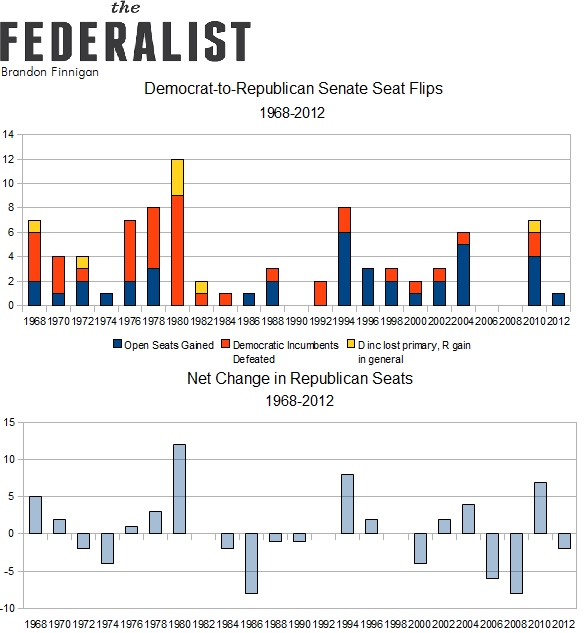
Whether you look here, the New York Times’ Upshot, Five Thirty Eight, or the Monkey Cage at the Washington Post, it is quite clear Republicans are favored to make gains in the U.S. Senate. Thanks in part to their success in 2010 and redistricting, Republican gains in the House won’t be nearly as impressive, leaving many in a tough spot: without massive gains in the House, what would constitute a wave this go-around?
Where Things Stand
Well, let’s review the previous gains made by Republicans over the course of the Sixth Party System, and their overall performance election-to-election:

Republicans made their most impressive gains in the oldest races by knocking out incumbents. From 1980 to 1984, Republicans beat more sitting Democrats than they have in the 14 elections since. In 1980, the biggest wave election for either party in decades, Republicans failed to flip the House of Representatives, but managed to unseat nine incumbents and defeated three more Democrats who beat incumbents in primaries. They are slight favorites currently in Arkansas, Louisiana, and Alaska, and if this holds, it would be a clear sign of a wave, since the Republicans haven’t exceeded two incumbent defeats in more than three decades.
More recently, Republican gains have benefited from Democratic retirements, mostly in Southern and Western states where the electorate has drifted red. This appears to be repeating itself in the current cycle: states in these regions whose Democratic senators were re-elected in 2008 are currently likely Republican (Montana, South Dakota, and West Virginia), whereas those with retirements in purple-to-blue Midwestern states are tossups to leaning Democratic (Iowa and Michigan). With less than 100 days to go, Republicans are favored to gain four seats through vacancies, tying 2010.
Republicans should be running strongly in the seats that went to Mitt Romney, and so far, they are, performing no worse than a tossup and winning the remaining six. Their performance in the purplish states of Iowa, Michigan, Colorado, Virginia, and New Hampshire is a bit more mixed, with incumbents more popular in the last two and dogfights in the first three. But that these are being discussed at all raises the number of interesting possibilities to a dozen seats. This without considering longer-shot races that have still raised eyebrows: Oregon, Minnesota, and New Mexico.
The Laws of Waves
After recapping the lay of the land, let’s try to establish a few “Laws of Waves.” Reviewing the numbers for Republicans, in no big elections where control of the Senate was wrestled away did a single Republican seat turn Democratic. Currently, Republicans are seeing their odds improve in Kentucky and Georgia, their two vulnerable seats. If the GOP offensive claims over a half-dozen seats in November, it is very difficult to picture either of these Southern states breaking in the opposite direction. This should be the most obvious characteristic of a wave: it washes across the country one way. If either David Perdue or Mitch McConnell lose, it is hard to envision Republicans successfully winning seven or eight Democratic seats to offset, and no wave would materialize.
Another “Law of Waves”: when it rains, it pours. States that broke Republican in the previous presidential election with opposing party seats should be the most vulnerable overall, but beyond these, other seats should become vulnerable because the underlying cause of the wave (usually voter disgust with the incumbent party) makes it tougher to campaign with the unpopular hyphen-letter. What begins as flips in obvious places cascades out to victories in far less likely places. This was true in 1980, 1986, 1994, 2006, 2008, and 2010, and would be expected in November if we saw a wave.
A final one: it has to be big enough to require an equally big pushback to be undone. The 1980 behemoth wasn’t undone for six years, the boomerang in 1986 was not reversed until 1994, that one until 2001, and the most recent one, 2006-2008, has yet to be. If Republicans won just six seats this cycle, their work could be quite easily squashed in just two years with Democratic victories in Illinois or Pennsylvania. But a win of eight or more would mean multiple wins out of Pennsylvania, Illinois, Wisconsin, Ohio, and Florida. With this last rule, we may have found our answer as to what would really constitute a wave.
The Magic Number: Eight
Current forecast models range, but most forecasters are expecting an average Republican gain of about six seats, just barely enough to win control of the upper chamber. As just mentioned, this wouldn’t constitute a wave, as it can be easily reversed. Also, considering that waves feature elections washed over beyond the expected, this result fails there too: it’s less than the number of gimme seats.
At a seven-seat gain, Republicans would presumably win all of their gimme seats or win six out of them and one tougher contest, a range of possibilities that may or may not satisfy those remembering law number two. Democrats would need to win two seats to undo the ultimate prize, the majority, and based on 2010 results, that is quite doable: Pennsylvania and Illinois were counted long into the night and barely went red then. With that, rule number three is broken.
At an eight-seat gain, however, Republicans have won all of the gimme seats, or at least six of them and two tougher races, and they match their performance in the 1994 revolution. Democrats would need to win Illinois, Pennsylvania, and Wisconsin to undo this in 2016 without any vulnerabilities of their own cancelling them out (Nevada and Colorado come to mind). It is also highly improbable that an eight-seat gain would be a “net” result wherein Democrats lost Kentucky or Georgia, satisfying the first law. For historical precedent, it would be very tough to argue “no wave” when eight meets or exceeds every previous wave besides 1980 in the past third of a century.
Of course, beyond eight it is silly to dispute a wave year. Nine, ten, or eleven seats would be downright catastrophic for Democrats, who face their own bad cycle again in 2018. At eight alone, Democrats face a very high likelihood of minorityship, with or without President Hillary, until at least January 2021. Above that? That fate is all but guaranteed, and James Carville will be staggering around wearing a waste basket for a good few days.









